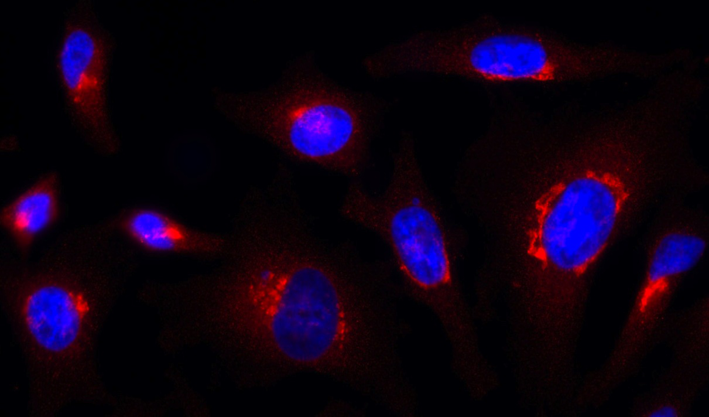
Rab1-GTP is detected by immunocytochemistry using anti-Rab1-GTP, mAb (ROF7) (Prod. No. AG-27B-0006). Method: HeLa cells are grown in standard culture conditions, fixed with paraformaldehyde (3%), permeablized in PBS+ BSA 0.2
anti-Rab1-GTP, mAb (rec.) (ROF7)
AG-27B-0006
ApplicationsImmunoPrecipitation, ImmunoCytoChemistry
Product group Antibodies
ReactivityCanine, Human, Mouse, Rat
Overview
- SupplierAdipoGen Life Sciences
- Product Nameanti-Rab1-GTP, mAb (rec.) (ROF7)
- Delivery Days Customer10
- ApplicationsImmunoPrecipitation, ImmunoCytoChemistry
- CertificationResearch Use Only
- ClonalityMonoclonal
- Clone IDROF7
- Concentration1 mg/ml
- Estimated Purity>95%
- HostHuman
- IsotypeIgG2
- Scientific DescriptionRab1 (Ypt1 in yeast) is a small GTPase that plays a well-established role in mediating ER-to-Golgi protein transport in both yeast and mammalian cells. Rab1 recruits effector proteins to budding COPII vesicles at the ER, forming cis-SNARE complexes that promote targeting to and fusion of these vesicles with the cis-Golgi. Rab1 is also involved in COPI vesicle formation and other distinct transport pathways, including ER-to-Golgi intermediate compartment (ERGIC)-to-cell periphery trafficking. Recently Rab1 has been shown to function in antimicrobial autophagy (autophagosome formation), as well as other forms of autophagy in mammalian cells in a way independent of ER-to-Golgi trafficking. anti-Rab1-GTP, monoclonal antibody (recombinant) (ROF7) is an antibody developed by antibody phage display technology using a human naive antibody gene library. These libraries consist of scFv (single chain fragment variable) composed of VH (variable domain of the human immunoglobulin heavy chain) and VL (variable domain of the human immunoglobulin light chain) connected by a polypeptide linker. The antibody fragments are displayed on the surface of filamentous bacteriophage (M13). This scFv was selected by affinity selection on antigen in a process termed panning. Multiple rounds of panning are performed to enrich for antigen-specific scFv-phage. Monoclonal antibodies are subsequently identified by screening after each round of selection. The selected monoclonal scFv is cloned into an appropriate vector containing a Fc portion of interest and then produced in mammalian cells to generate an IgG like scFv-Fc fusion protein. - Recombinant Antibody. Recognizes human, mouse, rat and dog Rab1a-GTP and Rab1b-GTP. Species cross-reactivity: Dog, Human, Mouse, Rat. Clone: ROF7. Isotype: Human IgG2lambda. Applications: ICC, IP. Host: Purified from HEK 293 cell culture supernatant. Liquid. In PBS containing 10% glycerol and 0.02% sodium azide. Rab1 (Ypt1 in yeast) is a small GTPase that plays a well-established role in mediating ER-to-Golgi protein transport in both yeast and mammalian cells. Rab1 recruits effector proteins to budding COPII vesicles at the ER, forming cis-SNARE complexes that promote targeting to and fusion of these vesicles with the cis-Golgi. Rab1 is also involved in COPI vesicle formation and other distinct transport pathways, including ER-to-Golgi intermediate compartment (ERGIC)-to-cell periphery trafficking. Recently Rab1 has been shown to function in antimicrobial autophagy (autophagosome formation), as well as other forms of autophagy in mammalian cells in a way independent of ER-to-Golgi trafficking. anti-Rab1-GTP, monoclonal antibody (recombinant) (ROF7) is an antibody developed by antibody phage display technology using a human naive antibody gene library. These libraries consist of scFv (single chain fragment variable) composed of VH (variable domain of the human immunoglobulin heavy chain) and VL (variable domain of the human immunoglobulin light chain) connected by a polypeptide linker. The antibody fragments are displayed on the surface of filamentous bacteriophage (M13). This scFv was selected by affinity selection on antigen in a process termed panning. Multiple rounds of panning are performed to enrich for antigen-specific scFv-phage. Monoclonal antibodies are subsequently identified by screening after each round of selection. The selected monoclonal scFv is cloned into an appropriate vector containing a Fc portion of interest and then produced in mammalian cells to generate an IgG like scFv-Fc fusion protein.
- ReactivityCanine, Human, Mouse, Rat
- Storage Instruction-20°C,2°C to 8°C
- UNSPSC12352203
